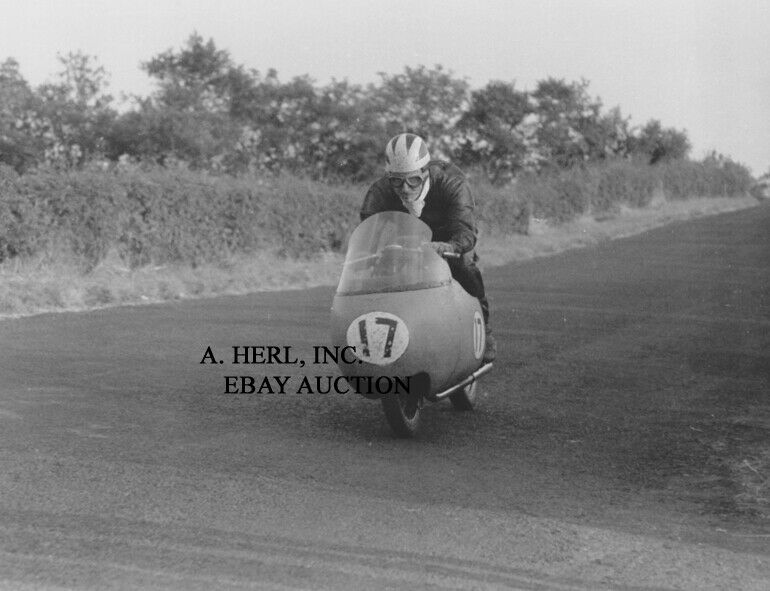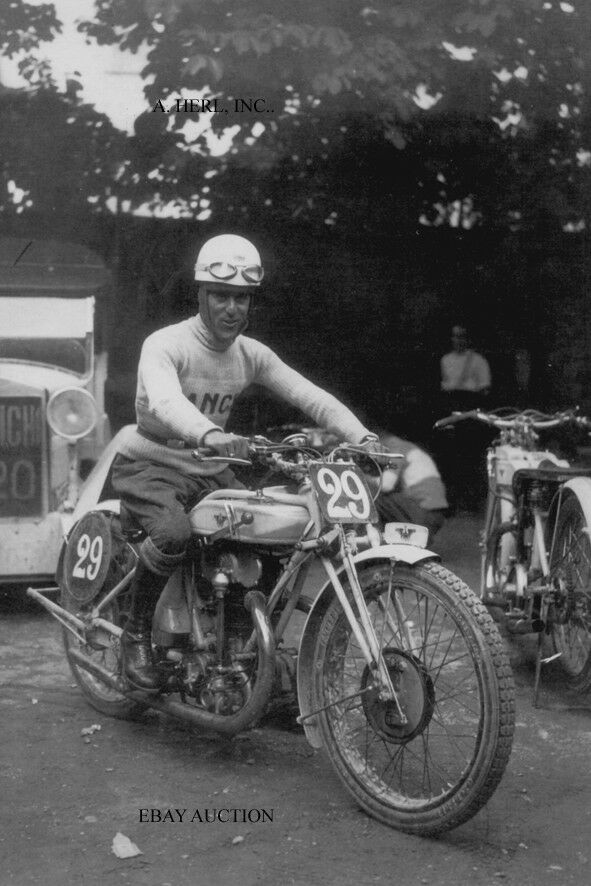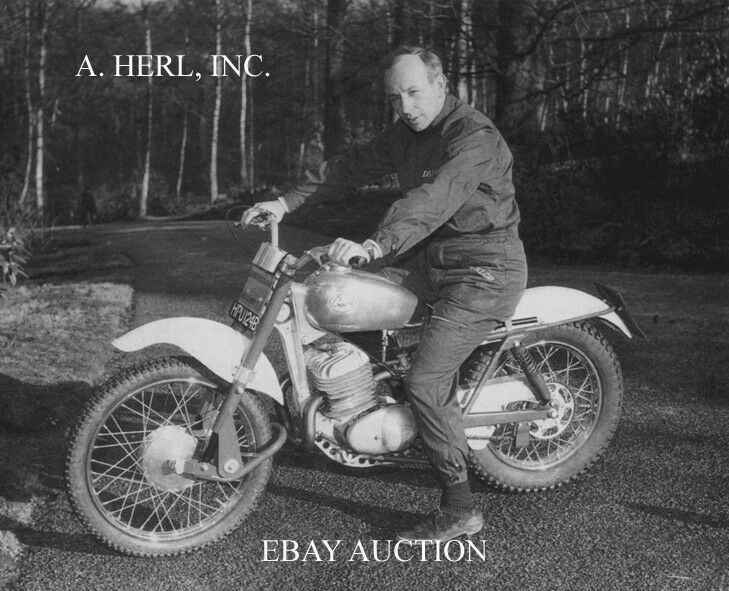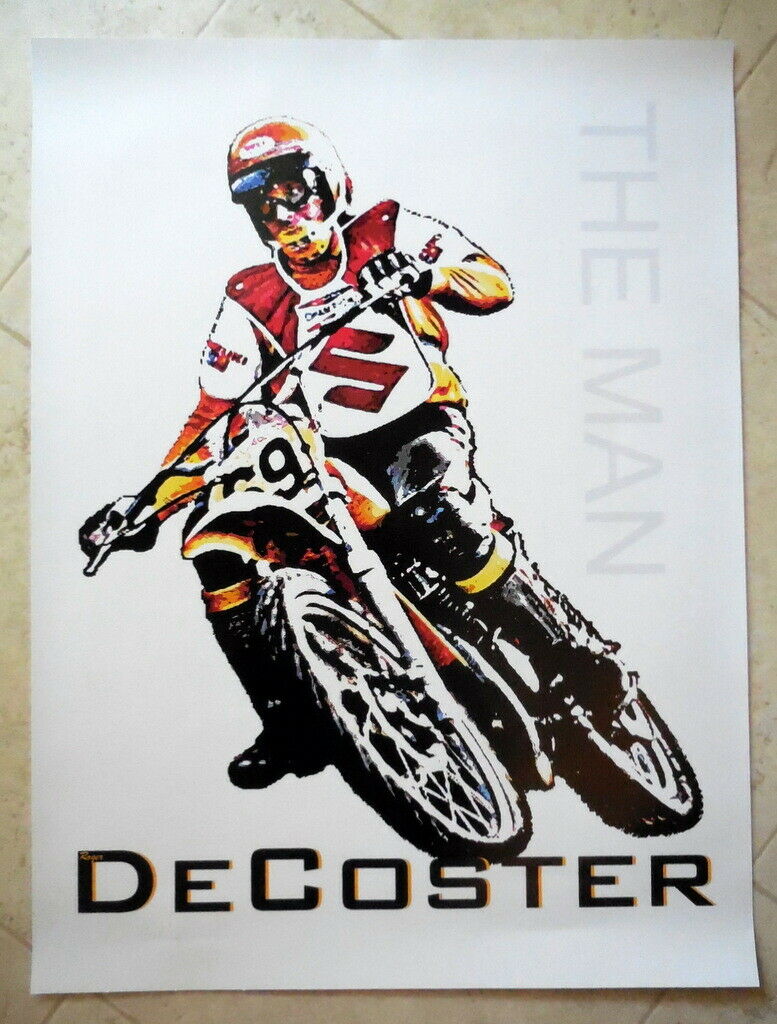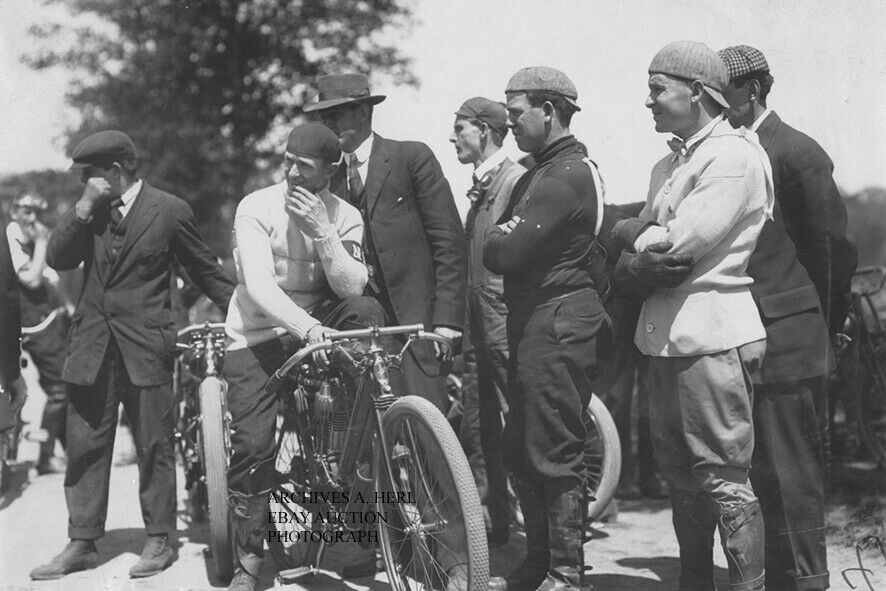-40%
Moto Guzzi 350cc dohc works racer Bill Lomas Ulster Grand Prix 1955 photo
$ 5.14
- Description
- Size Guide
Description
A superb and rare photo, made from what we believe is the original negative, of the magnificent 1955 and 1956 350cc World ChampionBill Lomas
and his
350cc Moto Guzzi d.o.h.c. Bialbero factory GP racer
as seen on the starting grid of the
1955
350cc Ulster Grand Prix
which was ridden on
August 13, 1955
. Bill Lomas would
win
the race with an average race speed of
89.31 mph
(
143.74 km/h
) AND he would go on to become the
350cc World Champion
on the
photographed machine
! Guzzi’s main and most experienced Grand Prix mechanic, “Moretto” Agostini, is also visible on this image on the outmost right, Lomas is talking to him.
Bill Lomas would
WIN
the 350cc world championship in 1955 and 1956 with the Moto Guzzi 350 single cylinder factory racers!
With their superb streamlining these wonderful machines won the 350cc world championship 5 times between 1953 and
1957. In
1953 Fergus Anderson won the 350cc world championship with the s.o.h.c. version of this successful racer. Its successor featured bevel driven double overhead camshafts and is visible on the photograph. The Guzzi sohc Grand Prix bikes were like its dohc successors designed by the famous ing. Giulio Cesare Carcano though Enrico Cantoni and Umberto Todero also played a vital role. They delivered a healthy power output of 38 hp at 8,000 rpm. Topspeed was
150 mph
! They were very special motorcycles, designed by somebody that is considered a genius.
Bill
Lomas
is truly one of the all time motorcycling greats and he also was a very, very sympathetic man. He won twice a world championship, in 1955 and
1956 in
the 350cc class as a member of the Moto Guzzi factory racing team; but he scored numerous second and third places in all classes throughout the 1950s world championships!
In the 1956 season, he also rode the famous V8 Moto Guzzi Grand Prix racer. He was one of the very few that actually could handle that motorcycle on the circuit. During his magnificent career
Bill
Lomas
rode for Royal Enfield, Velocette, AJS, Matchless, NSU, Benelli,
Moto
Guzzi
and
MV
Agusta
. He rode over 29 different machines in total in a career that makes today's lifelong marque associations look simply lazy. Racing against fellow all-time greats from what many regard as the golden Age of biking, including
Geoff
Duke
,
Bob
McIntyre
,
John
Surtees
and
Carlo
Ubbiali
, he took a double win at the 1955 TT to cap the nine Silver Replicas he earned on the
Island
, and numerous GP wins in other classes. Away from the roads and short circuits he was also an expert trials rider, and an accomplished engineer who was renowned for his ability to help teams develop bikes. Only an accident during the 1957 season curtailed his career, at just 29. He stayed within motorcycling opening successful dealerships. His status as a great was confirmed by the longstanding respect he was afforded back in
Italy
. He was also invited by MV to be part of many events, and travelled the world as an ambassadorial figure for the sport.
Bill
Lomas
also was a very accomplished engineer, which he displayed many times with his own tuned and improved racing and trials bikes. In his youth he was more then an accomplished athlete. Undoubtedly, if he would have chosen to compete in track and field, he still would be as famous as he is today as well.
The
Ulster Grand Prix
is a motorcycle road race that takes place on the Dundrod Circuit near
Belfast
,
Northern Ireland
. The first races took place in 1922 and in 1935 and 1948 the Fédération Internationale de Motocyclisme gave it the title Grand Prix d'Europe. The Ulster Grand Prix was included as one of the races in the inaugural 1949 Grand Prix motorcycle racing season, a place it held until 1971. It also counted for the TT Championship between 1979 and 1990. According to the race organisers, it is the fastest road race in the world. Thomas Moles, motorcycle enthusiast and Member of Parliament, helped to push through parliament the
first Road
Races Act, which made it legal for the Clady Course to be closed for the first Ulster Grand Prix on 14 October 1922. That first race had 75 entries in four classes (250cc, 350cc, 600cc and over 600cc). The race has been held on three different circuits. The
20.5 mile
Old Clady circuit was used from 1922 until 1939 and included a notoriously bumpy 7-mile straight. It also ran across part of the grass runway at RAF Aldergrove and for the first two years of its existence the pits were on the Seven Mile Straight, by
Loanends
Primary School
. In 1926 the 500cc race was won by Graham Walker on a Sunbeam. He also won the 1928 Senior race on a Rudge. In the 1936 Lightweight (250cc) event, Ginger Wood and Bob Foster, both on New Imperials, crossed the line so close, that after over
200 miles
of racing, it took the judges an hour to decide that Wood was the winner by one-fifth of a second. Foster was, however, adjudged to have achieved the fastest lap. The 1939 Grand Prix was almost called off, but went ahead in spite of an entry of only 60 riders. After World War II the new Clady circuit was used that, due to road improvements, was now
16.5 miles
in length and in use between 1947 and
1952. In
1953 the race was moved to the
7.401 mile
Dundrod Circuit where it is still held. The event was cancelled in 1972 because of the political situation in
Northern Ireland
and in 2001, during the Foot-and-mouth crisis, when the
North West
200 and Isle of Man TT were cancelled, the race was held. The 2007 Grand Prix attracted an entry of 162 riders, including 38 new riders, and took place on 18 August 2007, sponsored by The Belfast Telegraph. Joey Dunlop won twenty four Ulster Grand Prix races during his career with Phillip McCallen winning fourteen races and Brian Reid nine wins. Some of the famous riders include: Stanley Woods (7 wins), Jimmie Guthrie, Jimmie Simpson, Artie Bell, Les Graham, Freddie Frith (3 wins), Geoff Duke (3 wins), John Surtees (6 wins), Ray Amm, Carlo Ubbiali (5 wins), Bill Lomas (3 wins), Mike Hailwood (7 wins), Giacomo Agostini (7 wins), Phil Read (3 wins), Bill Ivy (3 wins), Bob McIntyre, Gary Hocking (3 wins), Tom Herron (5 wins), Ron Haslam (5 wins), Jon Ekerold, and more recently Mick Grant, Wayne Gardner, Steve Hislop, Robert Dunlop (9 wins) and Carl Fogarty. The most recent rider to join the famous riders group is Guy Martin (5 wins).
Moto Guzzi
, also known as Guzzi, is the oldest European manufacturer in continuous motorcycle production. Established in
1921 in
Mandello del Lario
,
Italy
, Moto Guzzi has led
Italy
's motorcycling manufacture, enjoyed prominence in worldwide motorcycle racing, and led the industry in ground-breaking innovation – for the greater part of its history. The company's history has been shaped by the importance of racing, engineering innovation and a constant adaptation to the changes in the motorcycle industry since its inception 1921. Moto Guzzi was conceived by two aircraft pilots and their mechanic serving in the Corpo Aeronautico Militare (the Italian Air Corp,
CAM
) during World War I: Carlo Guzzi, Giovanni Ravelli and Giorgio Parodi. By happenstance assigned to the same Miraglia Squadron based outside
Venice
, the three became close, despite starkly different socio-economic backgrounds. The trio envisioned creating a motorcycle company after the war. Guzzi would engineer the motor bikes, Parodi (son of wealthy Genovese ship-owners) would finance the venture, and Ravelli (already a famous pilot and motocycle racer) would promote the bikes with his racing prowess. Guzzi and Parodi (along with Parodi's brother) formed Moto Guzzi in 1921. Ravelli, ironically, had died just days after the war's end in an aircraft crash and is commemorated by the eagle's wings that form the Moto Guzzi logo. Carlo Guzzi and Giorgio Parodi, along with Giorgio's brother Angelo, created a privately held silent partnership "Società Anonima Moto Guzzi" on 15 March 1921, for the purpose of (according to the original articles of incorporation) "the manufacture and the sale of motor cycles and any other activity in relation to or connected to metallurgical and mechanical industry". The formation of the company hinged on an initial loan of two thousand Lira from the Parodis' father, Emanuele Vittorio, which he gave on 3 January 1919, offering the balance of the loan upon his review of the project's progress: Dear Giorgio, you can let both your partners know that I will offer you for your first 1,500 or 2,000 Lire. Although with the condition that the sum, under no circumstances, shall be increased. Likewise, I reserve the right to supervise your progress before giving my agreement to this project. The company was legally based in
Genoa
,
Italy
, with its headquarters in Mandello. The very earliest motorcycle bore the name G.P. (Guzzi-Parodi), though when it started the marque had changed its name to Moto Guzzi. As the only actual shareholders, the Parodi's wanted to shield their shipping fortunes by avoiding confusion of name G.P. with Giorgio Parodi's initials. Carlo Guzzi initially received royalties for each motorcycle produced, holding no ownership in the company that bore his name. In 1946 Moto Guzzi formally incorporated as Moto Guzzi S.p.A. with Giorgio Parodi as chairman. Carlo Guzzi's first engine design was a horizontal single that dominated the first 45 years of the company's history in various configurations. Through 1934, each engine bore the signature of the mechanic who built it. As originally envisioned, the company used racing to promote the brand. In the 1935 Isle of Man TT, Moto Guzzi factory rider Stanley Woods performed an impressive double victory with wins in the Lightweight TT as well as the Senior TT. Until the mid 1940s, the traditional horizontal four-stroke single cylinder 500 cc engines outfitted with one overhead and one side valve (also known as: IOE, inlet over exhaust or F-head) were the highest performance engines Moto Guzzi sold to the general public. By contrast, the company supplied the official racing team and private racers with higher performance racing machines with varying overhead cam, multi-valve configurations and cylinder designs. In the 1950s, Moto Guzzi, along with the Italian factories of Gilera and Mondial, led the world of Grand Prix motorcycle racing. With durable and lightweight 250 cc and 350 cc bikes designed by Giulio Carcano, the firm dominated the middleweight classes. The factory won five consecutive 350 cc world championships between 1953 and
1957. In
realizing that low weight alone might not continue to win races for the company, Carcano designed the V8 500 cc GP race bike—whose engine was to become one of the most complex engines of its time. Despite the bike's having led many races and frequently posted the fastest lap time, it often failed to complete races because of mechanical problems. Ultimately, the V8 was not developed further as Moto Guzzi withdrew (together with the main competitors Gilera and Mondial) from racing after the 1957 season citing escalating costs and diminishing motorcycle sales. By the time of its pull out from Grand Prix racing, Moto Guzzi had won 3,329 official races, 8 World Championships, 6 Constructor's Championships and 11 Isle of Man TT victories. The period after World War II was as difficult in Mandello del Lario as it was elsewhere in post-war
Europe
. The solution was production of inexpensive, lighter cycles. The 1946 "Motoleggera", a 65 cc lightweight motorcycle became very popular in post-war
Italy
. A four-stroke 175 cc scooter known as the "Galletto" also sold well. Though modest cycles for the company, the lighter cycles continue to feature Guzzi's innovation and commitment to quality. The step-through Galletto initially featured a manual, foot-shifted three-speed (160 cc) configuration then later a four-speed (175 cc) set-up by the end of 1952. The displacement was increased to 192 cc in 1954 and electric start was added in 1961. Moto Guzzi was limited in its endeavors to penetrate the important scooter market as motorcycle popularity waned after WWII. Italian scooter competitors would not tolerate an incursion from Moto Guzzi. By innovating the first large-wheeled scooter, Guzzi competed less directly with manufacturers of small-wheeled scooters such as Piaggio (Vespa) and Lambretta. To illustrate the delicate balance within the Italian post-war motorcycle and scooter markets, when Guzzi developed their own prototype for a small-wheeled scooter, Lambretta retaliated with a prototype for a small V-twin motorcycle threatening to directly compete on Moto Guzzi's turf. The two companies compromised: Guzzi never produced their small-wheeled scooter and Lambretta never manufactured the motorcycle. Notably, the drive train that Lambretta made in their 1953 motorcycle prototype remarkably resembles the V-twin + drive shaft arrangement that Guzzi developed more than ten years later, ultimately to become iconic of the company. By 1964, the company was in full financial crisis. Emanuele Parodi and his son Giorgio had died, Carlo Guzzi had retired to private life, and direction passed to Enrico Parodi, Giorgio's brother. Carlo Guzzi died on 3 November
1964, in
Mandello, after a brief hospital stay in Davos. In February 1967, SEIMM (Società Esercizio Industrie Moto Meccaniche), a state controlled receiver, took ownership of Moto Guzzi. The SEIMM oversight saw Moto Guzzi adapting to a cultural shift away from motorcycles to automobiles. The company focused on popular lightweight mopeds including the Dingo and Trotter — and the 125 cc Stornello motorcycle. Also during the SEIMM years Guzzi developed the 90° V twin engine, designed by Giulio Cesare Carcano, which would become iconic of Moto Guzzi. Though Moto Guzzi has employed engines of myriad configurations, none has come to symbolize the company more than the air-cooled 90° V-twin with a longitudinal crankshaft orientation and the engine's transverse cylinder heads projecting prominently on either side of the bike. The original V-twin was designed in the early 1960s by engineer Giulio Cesare Carcano, designer of the DOHC V8 Grand Prix racer. The air-cooled, longitudinal crankshaft, transverse cylinder, pushrod V-twin began life with 700 cc displacement and 45 hp (34 kW) – designed to win a competition sponsored by the Italian government for a new police bike. The sturdy shaft-drive, air-cooled V-twin won, giving Moto Guzzi renewed competitiveness. This 1967 Moto Guzzi V7 with the original Carcano engine has been continuously developed into the 1200 cc, 80 hp (60 kW) versions offered today (2006). Lino Tonti redesigned the motor for the 1971 Moto Guzzi V7 Sport. This engine is the basis of the currently used 750 cc, 1100 cc and 1200 cc Guzzi engines. Notably, the longitudinal crankshaft and orientation of the engine creates a slight gyroscope effect, with a slightly asymmetrical behavior in turns. After experiencing financial difficulties in the late 1960s, De Tomaso Industries Inc. (D.T.I. Group or DTI), manufacturer of the De Tomaso sports and luxury cars, owned by Argentinian industrialist Alejandro de Tomaso, purchased SEIMM (and thereby Moto Guzzi) along with Benelli and Maserati in 1973. Under Tomaso's stewardship, Moto Guzzi returned to profitability, though other reports suggest a period of limited investment in Moto Guzzi followed attributed to DTI using Moto Guzzi financially prioritizing their automotive ventures.
This is a very nice and very rare
non period
photo that reflects a wonderful era of Moto Guzzi ‘s rich motorcycle history in a wonderful way. This is your rare chance to own this photo, therefore it is printed in a nice large format of ca. 8" x 12" (ca. 20 x
30 cm
). It makes it perfectly suitable for framing!
Check out our other Ebay auctions or contact us for more Moto Guzzi and other motorcycle images
and use the shipping discount! You can always contact us for any requests. Please check out our Ebay auctions and take advantage of our shipping discount!
Check out our other Ebay auctions or contact us for more motorcycle and car (racing) photos! Combine auctions and save on shipping.
Shipping costs will only be $ 7.00 regardless of how many photos you buy. For 5 or more photos, shipping is free!
(Note: A. Herl, Inc. does not appear on photo, for ebay purposes only)
No copyright expressed or implied. Sold as collectable item only. We are clearing out our archives that we have gathered from various sources.
All items always sent well protected in PVC clear files
and board backed envelopes.
We have photographs that came from professional collections and/or were bought from the original photographer or press studio! They are all of professional and excellent quality.
After many decades of professionally collecting photographs and posters we are clearing out our archives. They make the perfect gift and are perfectly suited for framing. They will look gorgeous unframed and will be a true asset nicely framed with a border. They are a gorgeous and great asset in every home, workshop, workplace, restaurant, bar or club!
First come - first served. And you can always contact us for your requests. Please ask any questions before the auction ends.
